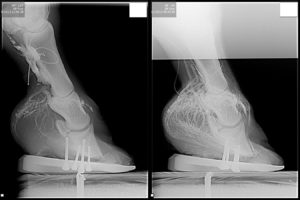How this New Therapy Heals Horses
by Kimberly Barber
Texas-based performance and show horse trainer Steve Cruse was given a grim prognosis for his client’s four-year-old appaloosa mare “Katelyn” after she foundered in June 2012. Venogram images—x-rays which show blood flow—of her feet in September 2012 revealed that in addition to rotation of the coffin bone, blood flow in Katelyn’s right-fore hoof was at about 25%. In an effort to get Katelyn sound and comfortable, Cruse acquired an equine therapeutic platform called a TheraPlate.
The TheraPlate, a patented product of TheraPlate Revolution, played a vital role in Katelyn’s recovery. This device utilizes a proprietary Vortex Wave technology to provide treatment and prevention of injuries and chronic conditions such as navicular and EPM. While similar to other whole body vibration therapies or “WBV,” the TheraPlate uses motion and energy to increase circulation, enhance performance and decrease recovery time for injuries (it does not vibrate or shake the body which can have adverse result).

What sets the TheraPlate apart from other WBV products is the Vortex Wave motors move in a circular motion, similar to a whirlpool or an airplane engine. This motion creates a vortex of energy and initiates involuntary muscle contractions, increasing muscle mass and bone density through maximum circulation with minimal wear and tear on the body. Vortex Wave therapy is impact and concussion free so injuries will not be further aggravated. Users have control of the power level of the motors at any given point during therapy with slight adjustments made with a dial on the control box. Level 1 is faint and provides a gentle stimulus to the body. Level 10 is powerful enough to make a human’s teeth chatter. This is used for deep muscle and bone therapies as well as circulation problems.
Along with corrective farrier care, Cruse followed a two-month plan with Katelyn on the TheraPlate. She stood on the plate three times a day for 20 minutes a session. A booklet of recommended therapy plans for issues from bowed tendons to back soreness is provided to users. The guide was developed by health-care professionals and TheraPlate. Cruse followed the recommended treatment for founder which was ultimately successful. A venogram taken in November 2012 showed a stop in the rotation in Katelyn’s right front coffin bone and an increase to 70% circulation in the foot. The mare was able to run sound in the field according to Cruse who had previously considered broodmare status only for the young horse prior to treatment.

Helping rehabilitate horses like Katelyn is why TheraPlate Revolution owner and founder Chip Kreiling said he is passionate about his product. “We are in it for the horses,” he said. “We are in it for people and for changing lives.”
Since conception, TheraPlate has been the subject of more than 200 peer-reviewed clinical studies as well as studies and trials in university veterinary and physical-therapy programs. The studies show the application of the Vortex Wave therapy in the rehabilitation of common problems found in horses of all disciplines including navicular, bowed tendons, back soreness, arthritis, poor hoof growth, PSSM and more.
Kreiling said a common result in both clinical studies and personal testimony from TheraPlate users was the reduction of healing time and creating a second chance for horses and people. Many cases are showing up to a 40 percent improvement over traditional treatments or stall rest.
The TheraPlate is made in the USA. The frame is made out of aircraft aluminum and the equine plate will hold more than 2,500 pounds. The frame comes with a lifetime warrantee and every purchase comes with a money-back guarantee. Multiple sizes from the 2’ by 2’ K4 stand-on human model to the 3’ by 7’ Equine model are available for a variety of needs. Aside from horse training facilities, the TheraPlate is being used by physical therapists, chiropractors and hippotherapy centers as treatment for joint diseases, improving balance, fibromyalgia, MS and leg and back pain.
Katelyn undergoes daily therapy on the TP and showed increased soundness in 2013. Venogram images from February 2013 showed continued improvement in Katelyn’s hooves and an increase in vessel density.
Published January 2014 Issue

The Northwest Horse Source is an independently owned and operated print and online magazine for horse owners and enthusiasts of all breeds and disciplines in the Pacific Northwest. Our contemporary editorial columns are predominantly written by experts in the region, covering the care, training, keeping and enjoyment of horses, with an eye to the specific concerns in our region.








